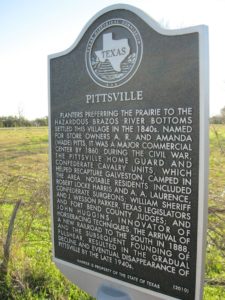Economic Development or Honey I bought a HEB
Do you think public-private partnerships as an economic development tool is a new 21st century concept? Corporate welfare a creation of the 20th century? Have you ever been to Pittsville, Texas?
An economic engine of the late 19th century was the railroad companies. Failure to donate land to bring the railroad to your town meant that the railroad bypassed your town. Think of the town of Rock Ridge in the movie “Blazing Saddles”!
Founded in the 1840s, Pittsville was bypassed by the railroad, which went through Fulshear instead. By the late 1940s, the last person moved away and Pittsville became a ghost town. No railroad, no town. Now, the only structure left of Pittsville is a historical marker. Donating property as a form of economic incentive drives economic development. Today, there are many tools cities can use to stimulate economic development and not become a ghost town.
Cities can create PIDs (Public Improvement Districts), MMDs (Municipal Management Districts), MDDs (Municipal Development Districts), TIRZs (Tax Incentive Reinvestment Zones), MUDs (Municipal Utility Districts), PUDs (Planned Unit Developments), tax abatements, tax reimbursement agreements, loans from the Governor’s leverage fund, and Development Agreements among many others using all letters of the alphabet.
One of the best tools for economic development is a “380” agreement, a reference to chapter 380 of the Texas Local Government Code that is only half a page long. We have used 380 agreements to great effect in bringing a HEB supermarket to a municipality that had no major grocery chain. The key provision of Chapter 380 simply states that
The governing body of a municipality may establish and provide for the administration of one or more programs, including programs for making loans and grants of public money and providing personnel and services of the municipality, to promote state or local economic development and to stimulate business and commercial activity in the municipality.

That 380 agreement provided for the donation of city property to a state law required independent foundation with a claw back provision and repurchase option if the property was not developed as required under a development agreement between the City and the Developer. The foundation then sold the property to the Developer. The Developer bought the property with funds granted to it from the City. The 380 development agreement contained use restrictions on the property as well as offsite improvements requirements to be provided by the City including drainage, streets and traffic signals. Also included were further grants by the City for site improvements to be completed by the developer. The City entered into a tax reimbursement agreement to reimburse property tax and sales tax for 15 years.
Requirements for the Developer included penalties for not opening the HEB by a date certain, detailed the type of store and merchandizing of the store, required a minimum size of the store, required deadlines for development of the remaining property and a minimum amount of green space, even detailing where trees can go. Hint: no trees in the parking lot because of birds.
What does the City gain? The continued vitality of the local economy, eventual sales tax collection and happy voters because of the excellent produce, meat and groceries provided by HEB. Beware of the Pittsville effect!
